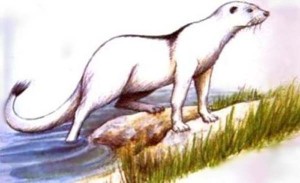The Dobharchu
Posted by: Loren Coleman on March 17th, 2010

Guest contributor today:  Paul Burns
Paul Burns

Though partially covered by lichens, the general shape of the Dobharchu can be seen here, as portrayed on Grace Connolly’s tombstone in Sligo County, Ireland.
Nobody wants to meet a Puca. More often than not this animal spirit is malevolent and is to be avoided. The Puca usually appears as a horse, though it can take the form of almost any animal. Several of my friends who are not well versed in Irish ways have named pets “Pooka,” and frankly I am cautious around them.
There are other animal spirits sometimes confused with the Puca. One is the Each-Uisge, or water-horse; and the other–an especially evil variety–is called the Dobharchu, or water-dog.
A recent social history called Echoes of a Savage Land, by Sligo historian Joe McGowan, recounts that September 22, 1722, Grace Connolly went from her home to nearby Glencade Lake to bathe. When she did not return, her husband Traolach McLaughlin went to search for her, and was horrified to find Grace’s mangled body on the lakeshore with a sated water fiend, the Dobharchu, lying asleep among the scattered remains.
McLaughlin slew the beast, but immediately another of that fearsome species sprang from the lake and attacked him. McLaughlin and his brother fled on horseback pursued for miles by the demon, but upon reaching Cashelgarran near Benbulben the horses gave out. The brothers placed their horses across the entrance to that ancient fort and prepared to fight for their lives. The Dobharchu charged at them with such violence that it thrust its head and forepart completely through one of the horses, and McLaughlin buried his dagger in its heart.
Grace Connolly’s tombstone in Conwell cemetery near Kinlough has on it a carving of a strange beast being stabbed by a dagger. Cashelgarran stone fort still stand beneath Benbulben, and both monster and horse are buried nearby. Bathers are seldom seen in Glencade Lake anymore.
Source: Sligo County Ireland Genealogy.
About Loren Coleman
Loren Coleman is one of the world’s leading cryptozoologists, some say “the” leading living cryptozoologist. Certainly, he is acknowledged as the current living American researcher and writer who has most popularized cryptozoology in the late 20th and early 21st centuries.
Starting his fieldwork and investigations in 1960, after traveling and trekking extensively in pursuit of cryptozoological mysteries, Coleman began writing to share his experiences in 1969. An honorary member of Ivan T. Sanderson’s Society for the Investigation of the Unexplained in the 1970s, Coleman has been bestowed with similar honorary memberships of the North Idaho College Cryptozoology Club in 1983, and in subsequent years, that of the British Columbia Scientific Cryptozoology Club, CryptoSafari International, and other international organizations. He was also a Life Member and Benefactor of the International Society of Cryptozoology (now-defunct).
Loren Coleman’s daily blog, as a member of the Cryptomundo Team, served as an ongoing avenue of communication for the ever-growing body of cryptozoo news from 2005 through 2013. He returned as an infrequent contributor beginning Halloween week of 2015.
Coleman is the founder in 2003, and current director of the International Cryptozoology Museum in Portland, Maine.










I love tales like these. Do not forget, though, that the word “Puca,” or “Pwca,” as it is known elsewhere, was the basis for the word “Puck,” which is of course Shakespeare’s immortal mischievous spirit. Of cose there are Pucas in the British Isles as well— they do damage there, too. 🙂
Excellent story, and most interestingly hints at the possibility of the lingering existence of all-but-extinct animals, which I, like anyone with a inveterate interest in cryptic aspects of our natural history, would think points to the fact that our understanding of the past as it’s presented to us as scientific fact and based on the fossil record is weak at best and that extinction is sometimes forestalled by remnant populations in hold-over ecological niches functioning as refugias.
When I think back to how the vast reaches of Eurasia must have been for most of the last two or three million years while our planet was subject then, as it still is, to glacial periods which dominated the northern hemisphere’s continental land-masses and how it stands in contrast to the last few thousand years now that glaciers are conspicuously absent from boreal latitudes. Once upon a time there may very well have been creatures that for lack of a better word would seem like monsters and worse. Occasionally ‘once upon a time’ is ‘now’.
Oh, and I took a look at the Wiki on ‘dobharchu‘ and really have to wonder if it couldn’t have been a remnant of some rare species of predatory otter or seal similar to a leopard-seal, that because of its aggressive nature might have been eliminated pretty quickly when humans with weapons arrived to defend themselves with lethal tools.
An artist claims to have seen one as recently as 2003.
Brilliant post- I know ‘Sligo County’ pretty well (we’d call it County Sligo, or just Sligo, though!) and have family there today, as well as in neighbouring Leitrim, my ancestral home! Also, Leitrim is home to the Glenade stone and famous dobhar-chú carving- but enough cross-county rivalry! Irish cryptids are vicious- stay back from the edges of the loughs, folks! The water dog takes no prisoners…
Happy St. Patrick’s Day to you all.
Definitely an otter 😉 😉 😉
The Bwcca of Gymru isn’t I think, described like an otter, but more of a Brownie.